- When to repot juniper bonsai
- What you need to repot juniper bonsai
- Repotting a juniper bonsai- complete steps
- Step 1: Remove the tree from the old pot
- Step 2: Remove old soil from the tree’s roots
- Step 3: Prune the roots
- Step 4: Test the position of the tree in the new pot
- Step 5: Place a pot bottom net in the new pot
- Step 6: Put some of the bonsai soil mix
- Step 7: Reposition the tree and spread the roots evenly
- Step 8: Secure the tree using wires/strings
- Step 9: Put the rest of the bonsai soil mix
- Step 10: Water the tree
- Step 11: Avoid strong wind and direct sunlight
When to repot juniper bonsai
Which time of the year to repot
Timing is crucial when it comes to repotting juniper bonsai or any bonsai for that matter. Choosing the right time ensures that your tree recovers quickly and minimizes stress during the process. While the specific timing may vary depending on the climate and the juniper species, there are some general guidelines to follow.
Best time to repot
The best time of the year to repot any juniper bonsai is very late winter to early spring, just before the tree enters its growth phase again. Repotting at this time of the year gives your tree ample time to develop a healthy root system during the growing season.
Be careful if the temperature gets cold below 40°F (5°C) anytime after repotting. If it does, your tree needs some protection from the cold, like putting it in a shed or greenhouse.
If you live in a warmer region, you may be able to repot in the beginning of fall as well. But when you do, do not make a hard prune on the root system. Your tree may not have enough time to recover before winter comes.
When not to repot
Avoid repotting during summer and winter. The growth of bonsai roots largely decelerates under a hot and stressful summer climate, after vigorous growth in spring. There is almost no root growth during winter and repotting can make them go through too much stress.
How often to repot
In general, juniper bonsai trees should be repotted every 2 to 3 years when they are young and every 3 to 4 years when they mature.
Before repotting, check the soil and roots to identify soil degradation and poor drainage. If the soil particles are broken down and no longer provide good drainage, you have to repot your trees despite the recommended frequency.
What you need to repot juniper bonsai
To repot a juniper bonsai tree, you need;
- new bonsai soil mix
- a pot bottom net
- a (new) bonsai pot
- bonsai scissors
- wooden chopsticks and
- string/wire.
Bonsai soil mix
Recommended soil mix for juniper bonsai is;
-Akadama: 50%
-Lava rock: 25%
-Pumice: 25%
Premixed
If you are looking to use premixed bonsai soil, the following product I found on Amazon best matches the mixture ratio for juniper bonsai (Bonsai Soil by The Bonsai Supply).
Bonsai Soil by The Bonsai Supply
(Link to Amazon)
Other premixed soil products for juniper (or coniferous) bonsai trees often contain tree bark. These may be good if you live in a hot and dry region like California or Texas but if not, they may keep too much moisture for juniper trees which prefer to be kept in well-drained, drier soil rather than very wet one.
Homemade
If you want to make your own soil mix at home, here are the ingredients you need.
(Link to Amazon)
I explained everything you need to know about juniper bonsai soil in the following post. If you are interested, please check it out.
As for Akadama, it is unique in the sense that it checks all the boxes to be a good bonsai soil. But it is quite expensive to purchase outside Japan. If you do not want to spend that much on Akadama, vermiculite is a good candidate for an Akadama alternative.
(Link to Amazon)
To know how to make bonsai soil at home and more about Akadama alternatives, please check the following posts.
If you are thinking about reusing bonsai soil that has been used for several years, I wouldn’t recommend it. Common bonsai soils have a lifespan of 2 to 7 years and it may not be in good condition anymore.
Bonsai pot
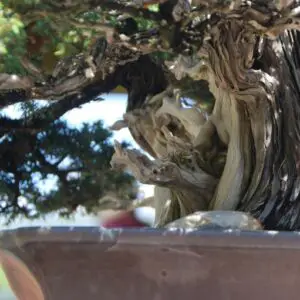
Juniper bonsai in a stoneware pot
When selecting a pot for your juniper bonsai, choose one made of stoneware if it is available. Stoneware pots have an earthy look that complements the rustic beauty of juniper bonsai. The naturalistic texture and color found in stoneware pots can create harmony with your tree and its style.
Look for one with a rectangular or square shape. The rectangular/square shape has a rigid and vigorous impression that matches the austere look of juniper bonsai trees. As to the color, dull reddish colors like purple and brown ones have a remarkable contrast with the beautiful green foliage throughout the year.
If your trees are in the training phase, a clay pot is ideal for their healthy growth.
To know more about which pot type to choose, the following post might be helpful.
Bonsai scissors
Bonsai scissors are different from ordinary garden pruners. They are made especially for the purpose of pruning tiny leaves in dense foliage and cutting off roots cleanly. Ordinary bypass pruning scissors are not for fine pruning and there is a risk of damaging roots and tearing branches.
These traditional bonsai scissors with a long shank (Ashinaga) shown below are my first choice because they are for general-purpose bonsai pruning that is good for both branch and root cutting.
Wazakura Ashinaga Bonsai Scissors
(Link to Amazon)
For more about bonsai scissors, please check the following post.
Repotting a juniper bonsai- complete steps
Step 1: Remove the tree from the old pot

Remove the tree from the old pot.
Refrain from watering for 24 hours so that the roots and soil can be removed from the pot easily.
If the roots are pot-bound, try these:
- Tap the rim of the pot several times and see if you can loosen the tree from the pot;
- Secure the tree, lean the pot at an angle and gently tap the rim of the pot; or,
- Use a small wooden (or metal) spatula/knife to gently make vertical cuts alongside the pot. Grab the bottom of the trunk and tease it very gently until you can loosen the tree.
Step 2: Remove old soil from the tree’s roots
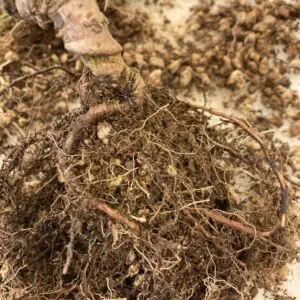
Remove old soil (this is a bit too much of removal.)
Using a wooden chopstick, gently remove half of the old soil from the tree’s roots so that you can observe the root system clearly. Be careful not to disturb too much the soil at the base of the trunk. The soil around the base of the trunk should be replaced slowly year by year and all be renewed after repotting 4 to 5 times.
Juniper roots are very fine and delicate. So make sure not to damage them.
Step 3: Prune the roots
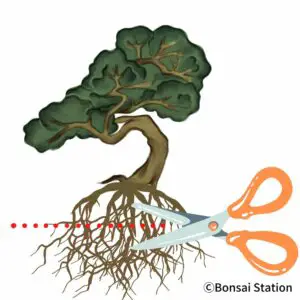
Prone the roots.
- overgrown roots that are longer than the depth of the new pot; and,
- dead or damaged roots.
You may be able to prune upto 1/3 of the root sytems but lesser is safer if you repot your tree for the first time.
Step 4: Test the position of the tree in the new pot
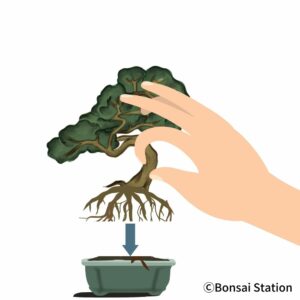
Test the position
- Decide the front of the tree and that of the pot.
- Put the tree in the new pot to test if its position is balanced.
- The tree can be positioned in either the center or towards the edge of the pot, depending of the style you want.
The front side of a bonsai tree is the side that looks most aesthetically pleasing from the viewing angle. If you are not sure how to position your tree in the pot, the article below will help you guide through it.
Step 5: Place a pot bottom net in the new pot
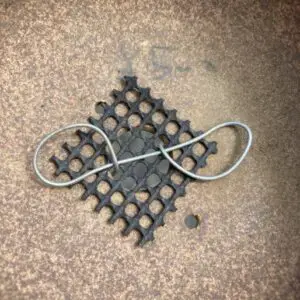
Pot bottom net
Place a pot bottom net in the new pot to cover the drainage hole(s).
Step 6: Put some of the bonsai soil mix
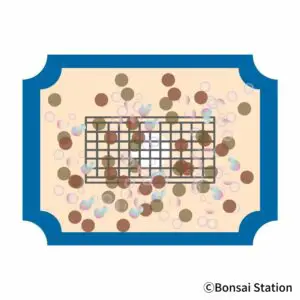
Put some of the soil mix.
Put some of the new bonsai soil mix to lightly cover the base of the pot. If the new pot is relatively deep, you can put a thin layer of bigger size Akadama/volcanic sand in the base of the pot.
Step 7: Reposition the tree and spread the roots evenly
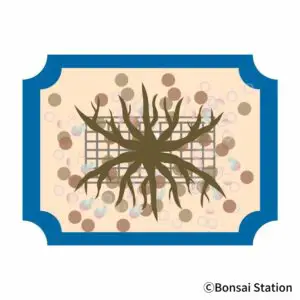
Reposition the tree and spread roots evenly.
- Carefully place the tree in the (new) pot.
- Keep in mind that the front of the tree and the pot is in the position decided in the previous step.
- Spread the roots evenly in every direction so that good surface roots (nebari) are developed.
Step 8: Secure the tree using wires/strings
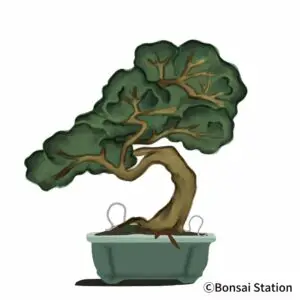
Secure the tree using wires/strings.
Secure the tree to the pot using wires/strings. The roots of the tree should be locked and immovable in the soil until the new roots regenerate.
Step 9: Put the rest of the bonsai soil mix

Put the rest of the soil.
- Put the rest of the bonsai soil mix in the pot.
- Use a wooden chopstick to gently push the soil into the air pockets.
- Add more soil and push the soil in between the roots.
- Repeat the process until all the gaps are filled and the soil is at the level just below the rim of the pot.
Step 10: Water the tree

Water the tree well. Pour water once, wait for a couple of minutes until the new soil absorbs water, and pour again. Pour water until it comes out of the drainage holes.
Step 11: Avoid strong wind and direct sunlight

Avoid strong wind and direct sunlight.
Do not let the new soil dry out and avoid strong wind as well as direct sunlight for a week after repotting. Wind and sunlight can be stressful to newly repotted trees.




